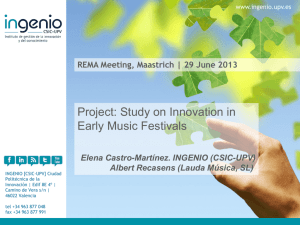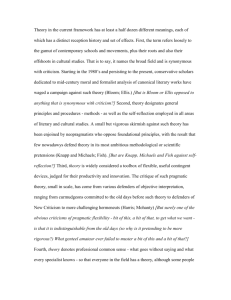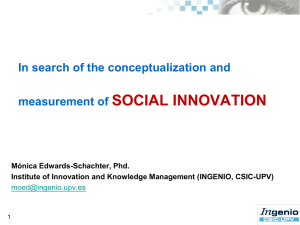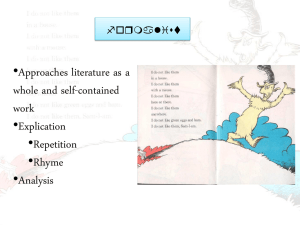Before Going Any Further With Social Capital: Eight Key
advertisement
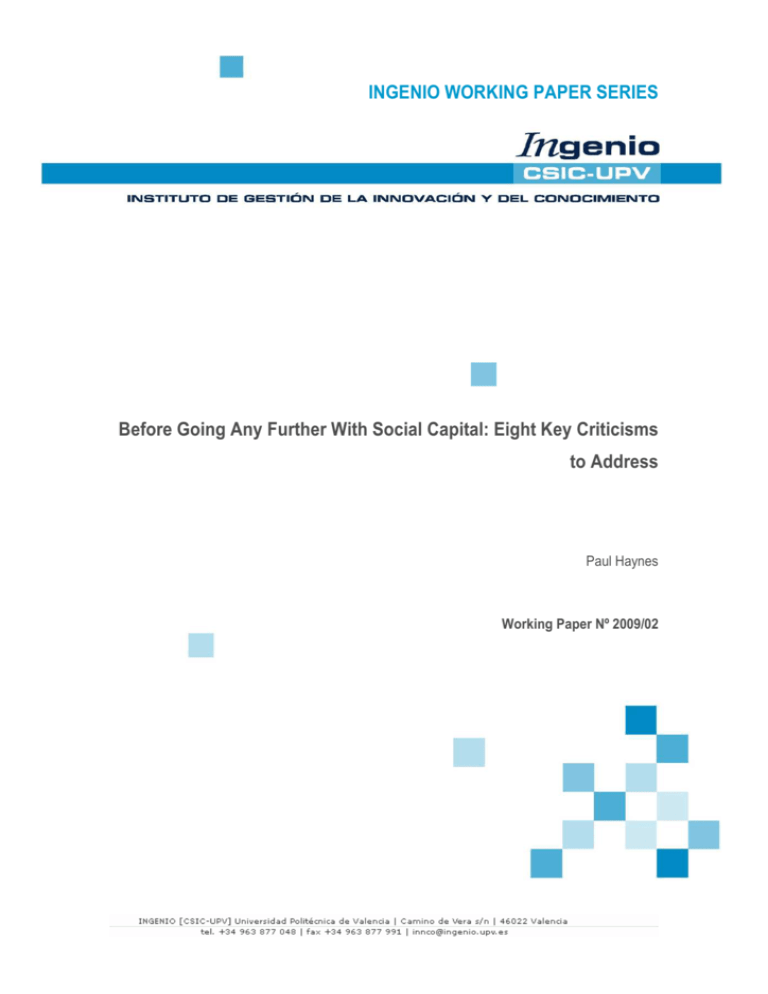
INGENIO WORKING PAPER SERIES Before Going Any Further With Social Capital: Eight Key Criticisms to Address Paul Haynes Working Paper Nº 2009/02 INGENIO (CSIC-UPV) Working Paper Series 2009/02 Before Going Any Further With Social Capital: Eight Key Criticisms To Address Paul Haynesa a Institute of Innovation and Knowledge Management, INGENIO (CSIC-UPV) Abstract The concept of social capital emerged as an influential research theme in a number of disciplines in the past twenty years, as measured by the exponential growth in social capital literature throughout the 1990s and the early 2000s. While some of the assumptions of social capital theory have been challenged individually, its limitations as a unified concept have not been adequately tackled within the academic literature. This paper is an attempt to address this challenge, identifying eight key questions that the concept needs to tackle. The paper concludes that a stronger concept of social capital will emerge only by addressing these limitations explicitly and as a cluster rather than individually. 1 INGENIO (CSIC-UPV) Working Paper Series 2009/02 Social capital is more than the sum of the various kinds of relationships that we entertain, and a social capital lens, therefore, can reveal features of reality that otherwise remain invisible (Adler and Kwom 2002: 36) The use of the concept of social capital as a tool of analysis for social scientists is relatively recent but already has a wide variety of meanings and uses across a range of disciplines (see Portes 1998; Woolcock 1998; Borgatti and Foster 2003). As might be expected with a concept treated so broadly as to be an explanation for a multiplicity of social changes and a panacea for pressing social problems, a number of weaknesses have been identified in different aspects of the concept and its use (Durlauf 1999; Schuller, Baron and Field 2000; Fine 2002) and yet notwithstanding these critiques, the concept has expanded into new areas of social science research, with the number of articles and citations continuing to grow (see Forsman 2005 Widén-Wulff 2007). In order to address the perceived limitations of the notion of social capital systematically, this paper will examine the way in which it has been conceptualised in an attempt to draw together the different lines of criticism directed towards the unity and meaning of the concept. This is done in order to identify the weaknesses of the concept of social capital as a concept, so that it can be clarified and reconceptualised in a less ideological way that is more focussed on the role it plays in explaining specific relationships. The intention of this paper is therefore not to dismiss the concept, but rather to set a number of challenges to scholars wishing to invoke it as a solution to a specific problem. If the concept really is more than the sum of the various kinds of relationships, as the quote that begins this article states, explaining and illustrating this “added value” as clearly as possible, will be a useful contribution to research centred on exploring these relationships. The first question this raises is that notwithstanding such bold claims, in the absence of a framework explaining the contribution of the term, why focus on the concept at all: it is a research term that already has a large literature without yet having generated much consensus. Indeed a number of critics suggest that despite its vast literature, or perhaps as a consequence, social capital fails to provide a unified or coherent concept at all. It is, they argue, a fundamentally elusive concept, explaining almost any social science 2 INGENIO (CSIC-UPV) Working Paper Series 2009/02 phenomenon with a “capacity to draw uncritically on any handy analysis” (Fine 2002: 796). Michael Woolcock argues that there are a number of forms or dimensions that are confusingly unified as a single concept: “social capital’s revisionist grounding in different sociological traditions risks trying to explain too much with too little” (Woolcock 1998: 155) noting: Ordinarily, a theory’s parsimony i.e., its capacity to explain the most with the least is a desirable property; in this instance, however, a single term is being adopted indiscriminately, adapted uncritically, and applied imprecisely(Woolcock 1998: 196) Ben Fine goes further, claiming that while it is presented as a tool of consensus for overcoming ideological divisions between left and right, it is, in fact, highly political in both neutralising dissent and systematically disregarding key questions and issues concerning the social problems it is claimed to address: Social capital is the degradation of scholarship, independent of its popularisation and potential self-help, win-win, reactionary overtones…Isolated occurrences aside, it can only be rejected, not appropriately transformed (Fine 2002: 799) While this may be true of some uses of social capital, particularly as a policy instrument or as a political objective in itself (see DeFilippis 2001: 800-801) many attempts have been made to clarify the concept in terms of its use in research (Lyons 2001; Sobel 2002); its definition, structure, and connection with other academic concepts (Burt 2000); and in terms of the unity of its component parts (e.g. Bjørnskov 2006). Although such scholarship attests to the perceived robustness of social capital as a potentially useful academic concept, there remain, however, a number of criticisms concerning its implications as a theory, and in terms of the type of explanations it affords. These criticisms are derived from a range of perspectives and assumptions rather than from a unified critique; nevertheless, their collective force is itself in some way parallel to the multiple perspectives invoking social capital in support of a wide range of phenomena. In order to engage with this multiplicity of critical positions the paper will address a small number of key criticisms of social capital and examine each criticism briefly and independently, with illustrations from the literature. The paper will then draw from these lines of critique in delineating a challenge to scholars likely to be drawn to the concept as a research device or explanatory tool. This challenge, therefore, is as follows: before the concept of social capital is introduced as an explanation or 3 INGENIO (CSIC-UPV) Working Paper Series 2009/02 description of events to support their research, scholars must be clear that it is able to add the value to their findings by being able to accomplish the work they expect it to perform. In order to develop a structure to address such a challenge, the paper will present eight criticisms of existing social capital framework. To address the challenge of demonstrating the relevance of a social capital lens, it will be necessary to develop a structure robust enough to simultaneously address each of these criticisms. While these criticisms are numbered, are not given any priority, though the first three criticisms address the reflexive nomenclature of the concept – the social, capital and theory aspects of the concept. Criticism 1: Social capital is a concept based on a misleading metaphor – it isn’t capital. Social capital seems to be different from other types of capital as described by economists. While this need no be a problem for the concept if it is coherently explained in relation to other forms of capital, or as a complementary part of the family of capitals, its difference to the convention notion of capital has been acknowledged but rarely interrogated. One example of such an interrogation is found in economist Kenneth Arrow’s work (Arrow 1999). Arrow argues that the word “capital” implies three elements: extension in time; an intended sacrifice for deferred benefit; alienability. Arrow concludes that the concept of social capital lacks each of the three elements required to be a genuine example of capital and therefore found no reason for “adding something called ‘social capital’ to other forms of capital” (Arrow 1999: 4). Further to this, those outside economics recognise that the difference with other forms of capital weaken the explanatory power of the concept through confusion with the functions of other forms of capital. For example Samuel Bowles argues that while the concept “social capital” might describe important relationships, the term itself and the way it is conceptualised in the literature, is so unlike other forms of capital that the term “social capital” should be abandoned: “Capital” refers to a thing possessed by individuals; even a social isolate like Robinson Crusoe had an axe and a fishing net. By contrast, the attributes said to make up social capital—such as trust, commitment to others, adhering to social norms and punishing those who violate them—describe relationships among people (Bowles 1999: 6) 4 INGENIO (CSIC-UPV) Working Paper Series 2009/02 Similarly, Robert Solow argues that the term social capital is an attempt to build on a bad analogy. He illustrates this in a powerful way by stressing that even by asking simple questions to develop the analogy (eg. what it is social capital a stock of? What is its rate of return?), it breaks down, a simple strategy that Solow demonstrates: “is the quickest way to explain why I doubt that ‘social capital’ is the right concept to use” (Solow 2000: 7). Solow concludes: I do not see how dressing this set of issues in the language and apparatus of capital theory helps much one way or the other (Solow 2000: 9) Claude Fischer argues that the term “social capital” is unnecessary as other clearer and simpler terms, such as membership, trust and sociability, serve perfectly well on their own. Indeed, even the supporting concepts of social capital, such as “bridging” and “bonding” fit better with a different metaphor, such as ties or association, while many of the reasons for using the term are based on conjecture, for example that trust norms are closely related to networks. A further danger is that the argument becomes susceptible to a slippery slope argument, i.e. that other features able to alter productivity are also a form of “capital”. Even before the content of the concept is examined, then, the use of the word “capital” is a hindrance that must be addressed and its meaning fully unpacked: the phrase itself is a problem. It is a metaphor that misleads: Where can I borrow social capital? What is the going interest rate? Can I move some of my social capital off-shore? (Fischer 2005: 157) With criticism coming from a variety of perspectives, the phrase, though, remains appealing to the degree that there is a reluctance to concede the concept just on the basis of a stretched metaphor. This is because the use of the term “social capital” has been strategically useful, identifying its function as a factor of production by associating the term with other (contested) concepts, such as human capital and intellectual capital. Indeed, Joel Sobel argues that even though “the strengths of the analogy are not persuasive enough to justify the terminology” (Sobel 2002: 145) the use of the term “social capital” can be justified because existing literature builds on this strategy and provides: convincing evidence that the topics under the social capital umbrella are worthy of study, and application of economic principles can provide important insights. 5 INGENIO (CSIC-UPV) Working Paper Series 2009/02 A vague keyword is not sufficient reason to condemn a promising line of research (Sobel 2002: 145) So while the flaw in identifying the concept too closely with functionally different notions has been acknowledged, scholars are persuaded that applying the economic principles from which the (flawed) concept is derived will be beneficial, though the keyword is not to be pushed too far, even though that is the very point of using this particular keyword in the first place. Nevertheless, the paper will turn to the other keyword in order to examine how such economic principles relate to the “social” dimension of the concept, and the criticism it has received. Criticism 2: Social capital is a concept indicative of the colonisation of sociological territory by fundamentally economic notions – it isn’t social. While scholars identify sociologists, such as Pierre Bourdieu and James Coleman as key figures in the development of social capital, there is the suggestion that it remains a fundamentally economic concept, fitting closely with the work of rational choice economists, such as Gary Becker, and, as such, is a Trojan horse through which mainstream economists seek, like Becker, to occupy terrain that had been the preserve of sociologists. using the phrase probably allows sociologists more access to the ears and wallets of the powers-that-be than simply writing about, say, friendship and church attendance. On the other hand, the term has reciprocally allowed economists to colonize sociologists’ topics (Fischer 2005: 157) Economists engaging with other social scientists could be a potentially a profitable undertaking for social science if new insights emerge within a collaborative exercise, but the notion of social capital is not engagement, but the application of an undiluted economic description on otherwise social terrain. In this way social capital is not an expansion though economic considerations, but a reduction to economic thinking. Ben Fine and Francis Green develop a similar argument, arguing that as well as being indicative of an unhealthy colonisation of the other social sciences by economics, social capital is also based on a reductionist argument. They argue that the concept is “reductionist across a number of dimensions: to the individual, to utility maximisation and to universal categories” (Fine and Green 2000: 91). Indeed, even without this direct 6 INGENIO (CSIC-UPV) Working Paper Series 2009/02 reduction to economic concepts that Fine and Green identify, social capital can be perceived as a reductionist concept even when its use purports to give a “social context” to relationships. This is because it erases the social in order to introduce the component used to contextualise it – simultaneously reifying the social and reducing it to characteristics of something else (see also Latour 2005: 3-6). Turning to Fine again: That “social” is attached to capital to mark a distinct category is indicative of the failure to understand capital as social in its economic, putatively non-social form (Fine 2002: 797) In this way, the “social” element of social capital is therefore supplementary, adding to and replacing the features of capital such that it undermines the concept of capital itself, for example capital is characterised as being depleted by utilisation; however, social capital is depleted by not being utilised. In this way, by introducing new forms of capital – social, human, knowledge – to fill in gaps in the concept, the meaning of the concept as a whole is actually eroded. This is because we can say less about the features that unifies the concept of “capital” than when it was strictly a form of non human factor of production. Additionally, social capital itself becomes a dangerous supplement (see Derrida 1976: 141-164), completing the economic explanation of a specific phenomenon without changing it, while simultaneous challenging this explanation, by indicating that the explanation was unsuccessful and thus needed to be changed. The social cannot supplement or contextualise economic explanations without changing them because it is not a substance, factor or context but is, instead a type of connection or the trace of other, non-social, associations. While the name “social capital” and its implications for conceptualising features such as trust or community and friendship ties in economic terms are shown to be problematic, this need not imply that the concept is inconsequential if it can expose something of the nature of networks or relationships that might otherwise be hidden. The social capital literature continues to grow and its application to new research questions continues to spread, implying that the concept has resonance with a wide range of questions or approaches: to paraphrase Victor Hugo, there is nothing as powerful as an idea whose time has come, especially if the idea has an appealing, even if misleading, name. The paper will therefore address this use of social capital in order to examine its potential as a theory or idea, before turning to its promise as an explanatory concept. 7 INGENIO (CSIC-UPV) Working Paper Series 2009/02 Criticism 3: Social capital is not an original concept, but rather a rebranding of a loose collection of themes related to trust and group participation from social psychology, sociology and economics – it isn’t a theory. Different fields of research use the word “theory” to mean different things, though it is generally taken to mean an explanation or descriptive assertion related to specified events. While there might be disagreement on exactly might constitute a theory, social capital doesn’t seem to possess the characteristics that would make it a theory at all. After difficulties with the social and capital dimension of the concept, the failure to generate theoretical analysis is, as Bruno Latour said of the theory element of Actor Network Theory in 1999, the third nail in the coffin: To a large extent social capital is “just” a powerful renaming and collecting together of a large swath of network research from the social support literature to social resource theory (Borgatti and Foster 2003: 993) Alejandro Portes, in his analysis of the various applications of social capital in sociology, suggesting that social capital as a rebranding exercise gives the range of processes a more attractive image under a unified concept: The set of processes encompassed by the concept are not new and have been studied under other labels in the past. Calling them social capital is, to a large extent, just a means of presenting them in a more appealing conceptual garb. (Portes 1998: 21) This rebranding gives the impression that the concept engages both the economic and the social dimension of association. While it might be true that social networks have economic value to participants, as a generalisation it hides as much as it explains. This is because by treating the concept as though it were a coherent whole and separated from the themes through which its meaning is derived, researchers will fail to explain how the specific mechanisms of trust, community, reciprocity, interpersonal relationships and networks impact on the features they are investigating. If, however, there is the assumption that the concept is greater than the sum of its parts and the complementarities of individual features add cumulative benefits, then this must be stated, the argument clarified and appropriate evidence mobilised. Indeed, combining a series of fragments from different conceptual perspectives is itself unlikely to produce a 8 INGENIO (CSIC-UPV) Working Paper Series 2009/02 consistent theoretical approach, but the actual theory building part of the social capital literature is minimal, with more of a “circus tent quality” (De Souza Briggs 1997: 111 cited in Adler and Kwon 2002: 18). In examining the research literature in great detail, Michael Woolcock concludes “that a single term is inadequate to explain the range of empirical situations demanded of it” (Woolcock 1998: 159) on the basis that a range of perspectives conceptualise the concept in different, and conflicting, ways: If social capital can be rational, pre-rational, or even non-rational, what is it not? At the very least, these different conceptualizations suggest that there may be various forms or dimensions of social capital. (Woolcock 1998: 156) Perhaps social capital can instead be conceptualised not as a functioning theory, but as an umbrella concept with which a variety of topics and social processes can be mapped, representing exactly the type of diversity identified by Woolcock, in the above quote. This may be an indication that the concept has value in the way it is used in describing, explaining or reformulating important phenomena, such as the appropriability of social ties (Coleman 1988: 108), rather than as a fully formed theory. To pause for a moment at this half-way stage of the paper, it is already very clear that the strong hypothesis that social capital is a theory able to explain the mechanism of resource exchange by seamlessly dovetailing the economic dimension with the social dimension of community life, is highly unconvincing. Most academics and researchers are, though, much less concerned with questions related to the conceptualisation of social capital, and much more interested in the localised effects of social capital-related themes in social or organisationally bounded outcomes. The paper will therefore examine some of the issues related to the practical details of the concept in addressing these local experiences, turning firstly to the high profile research that brought the concept to popular attention, beginning with an examination of the status of these explanations. Criticism 4: Social Capital is not an explanation but rather a tautology. A key weakness, even for some of the most influential social capital explanations (for example Putnam 1993), is that they begin with the effects of social capital and describe the differences between positive and negative examples in terms of the way social 9 INGENIO (CSIC-UPV) Working Paper Series 2009/02 capital has been responsible for producing these effects. These explanations are thus not explanations at all, but rather circular arguments. As Portes points out, when Putnam argues that a town is “civic” because it has civic participation and “incivic” if it doesn’t, it explains nothing since: “equating social capital with the resources acquired through it can easily lead to tautological statements” (Portes 1998: 5). Untangling the causes, effects, correlations and conjunctions is a difficult undertaking when dealing with networks and complex interdependencies, and bold claims should be based on theory, a mechanism, excellent case studies or other solid empirical findings, preferably triangulated with other data. And yet it is exactly the bold claims made on behalf of social capital that are gaining it currency (DeFilippis 2001: 801) claims based on colocation (Fischer 2005) the product of many additional factors that difficult to reduce to mere resources. Furthermore, the research analysis into the loss of social capital is equally flawed in failing to consider or give attention to ways in which social relationships have found new ways of expressing themselves (see also Lin 1999: 43-48). Technology mediated communication through blogs, posting on message boards, or social networking, with its 500 million members, lead to social interaction, relationships, campaigning and dissemination of knowledge (see, for example, Williams and Gulati 2006). Robert Wuthnow, for example, shows that there are indeed changes in participation rather than a decline, with shifts from bureaucratic forms to more ad hoc forms of participation, which have manifested themselves in many forms that social capital research has not always picked up on (Wuthnow 1998). When it is convenient to explain change in terms of social capital-like ways, such intangible resources can be invokes, and yet when there is a need to show the absence of social capital, these networks and modes of communication can be conveniently downscaled in importance. Social capital interpreted as the “right kind of connectivity” can be a form of hindsight bias or confirmation bias even when it seems to be a cogent explanation. Criticism 5: Related to the previous criticism of circularity is the problem of the direction of causality. Changes in social capital and changes in communities, even if they are related, it is difficult to show which direction causality originated. 10 INGENIO (CSIC-UPV) Working Paper Series 2009/02 While circumstantial evidence suggests that social capital, as measured in terms of active participation in associations that knit society together is associated with perceptions of decline in the community (see Putnam 2000) if the two are causally related, its direction that has not been fully resolved, as Steven Durlauf notes: Do trust-building social networks lead to efficacious communities, or do successful communities generate these types of social ties? As far as I know, no study has been able to shed much light on this question (Durlauf 1999: 3) More recently, a number of studies have attempted to provide a causal relationship using different methods (see, for example, Rose 2000; Mohan and Mohan 2002; Landry, Amara, and Lamari 2002); however, even these results are far from conclusive. The lack of precision concerning the causes and consequences of features associated with social capital is a direct consequence of operating a multiplicity of concepts under the same umbrella term. The importance of trust, social support and social exchange depend on different mechanisms and the nature of the interdependencies and feedback mechanisms that exist between these factors in different circumstances is not clarified by grouping them together as homogenous components. The complex nature of the interdependencies and feedback dynamics implies that linear descriptions of causality are unenlightening at best and in danger of presenting inappropriate policy instruments, and yet the literature, while acknowledging this challenge, neither address it, nor challenge the conventional direction of causality: mapping [social capital ties] poses a considerable challenge: from a purely technical point of view, it is far easier to map a small number of ego networks than to generate an intelligible sociocentric, whole-network map of a large complex organization. Hopefully, future researchers will develop ways to simplify this mapping task. (Adler and Kwon 2002: 36) From a purely technical point of view, then, the type of network map required to support the claims that extend beyond single organisations to clusters, communities and regions are well beyond the capabilities of researchers, even as they appeal to data said to provide such a map (see Putnam 1993: 6-7). Criticism 6: Social capital is difficult enough to define, but it is impossible to measure. 11 INGENIO (CSIC-UPV) Working Paper Series 2009/02 Following from the difficulty of defining and mapping social capital’s network contours is another pressing problem: that of measurement and other empirical indications related to the amount, or the importance of recent changes, in the type and quantity of social capital. Neither social capital nor its effects can be accurately measured in comparable ways, with some very influential research based exclusively on oversimplified measures and misleading comparisons (see Maraffi1994; Morlino 1995). Other attempts require reconceptualising social capital as assets or resources embedded within networks or to the value of a position within such networks, though these surrogates are based upon valuations of wealth, power, and status or access to bridging facilities (see Lin 1999: 37-38) and, as such, are factors that are arbitrarily valued or difficult to determine or grossly oversimplified. The most cited measures and statistics are also those with the most narrow conception of the concept, i.e. those cited by Robert Putnam, in which large United States data sets, in particular the General Social Survey and other longitudinal, national surveys, are analysed in detail to detect changes in a number of key measurements to account for the decay of social capital and a decline in engagement in American society (Putnam 2000). Rather than giving clear indications of such change, the research data is, on closer inspection, inconclusive. In an attempt to reconstruct Putnam’s findings using the same measures as Putnam, though on a smaller scale (trust, voting, church attendance, organisation membership, meeting with neighbours and friends, philanthropic giving) Claude Fischer shows that the relationships between the variables Putnam associates with social capital is not supported by the data: The controls do little to improve the picture of quite modest associations for items meant to all indicate one thing. This is, of course, only a quick look, not an in-depth analysis. But if the “social capital” concept presumes a tight interconnection among its various elements, that does not immediately appear in the data (Fischer 2005: 165) Methodological limitations also compound the problem. Foley and Edwards (1999) found that various attempts to quantify attitudes, norms, and social trust at a national level, yield no information as to which groups possess usable social capital. Steven Durlauf, examines the most cited “benchmarked” empirical research, and concludes that “the use of observational data to identify substantive forms of social capital is unlikely to be successful” (Durlauf 2002: F477). Attempting to develop a unit of analysis small 12 INGENIO (CSIC-UPV) Working Paper Series 2009/02 enough to capture the effects of social capital in facilitating the dissemination of resources to groups or individuals, has limited data collection to a reliance on methods such as questionnaires, which provide data with which it is difficult to make the distinctions between outcomes of social capital with forms or indicators of its presence. Durlauf considers that social capital can be researched but is cannot permit the type of analysis with the clarity and precision that the advocates in the field claim: The empirical social capital literature seems to be particularly plagued by vague definition of concepts, poorly measured data, absence of appropriate exchangeability conditions, and lack of information necessary to make identification claims plausible. These problems are especially important for social capital contexts as social capital arguments depend on underlying psychological and sociological relations that are difficult to quantify, let alone measure (Durlauf 2002: F475) These are not the only likely limitations, as there are also problems associated with capturing the impact of period, cohort and lifecycle factors, identifying “nested” interaction factors and community context variables, in addition to problems of scale when evaluating aggregates. Each of these factors requires a different methodological approach. Economic experiments are one potential area that Durlauf considers might give some limited data, though he concludes that when examining the difficulties of the objective: “the use of observational data to identify substantive forms of social capital is unlikely to be successful” (Durlauf 2002: F477). Examining the literature of the past six years provides no counter-example with which to challenge this conclusion. Criticism 7: Social capital, as outlined in the literature, can be a hindrance to economic success, with different types of negative externalities, barriers to meritocratic and efficient decision making. Social capital has a dark side. A further set of problems for the concept of social capital relate to the negative effects of social networks. Social capital, as described by leading advocates such as Robert Putnam (2000), relates as much to the negative consequences of networks as to the positive but even though there is a growing recognition that often one person’s advantage from social capital is at the opportunity cost of the exclusion of another, most research emphasises the positive aspects of network relationships linked to social 13 INGENIO (CSIC-UPV) Working Paper Series 2009/02 capital, though a growing amount of research addresses this imbalance (see Adler and Kwon 2002: 30-31; Portes 1998: 15-18; Quibria 2003: 29). So if the social capital thesis were correct, i.e. that greater participation in social networks provides more opportunities for participants and communities, this implies that there is a trade-off between features such as community solidarity and individual freedom, create barriers to meritocracy, while at the same time suggesting that increases in social capital also enable opportunities for pursuing negative or anti-social ends. Mancur Olson, for example, illustrated the way professional associations, trade unions and trade associations can sometimes hinder the economic opportunities of members by placing obligations and restrictions on their activity (Olson 1982) and other forms of limitations or negative externalities have been observed in much the same way as positive effects are said to emerge from social capital: Sociability cuts both ways…it can also lead to public “bads.” Mafia families, prostitution and gambling rings, and youth gangs offer so many examples of how embeddedness in social structures can be turned to less than socially desirable ends (Portes 1998: 18) Indeed, the three key factors affording social capital – source of social control, source of family support, source of benefits through related networks – can each be reinterpreted as hindrances to effective decision making through imposing obligations, implying restrictions or exclusion, and entailing unintended consequences and uncertainty. Putnam suggests that such problems can be the result of an imbalance of bonding and bridging social capital in the way that “bridging social capital can generate broader identities and reciprocity, whereas bonding social capital bolsters our narrower selves” (Putnam 2000: 23); however, as with the description of civil society, the notion of “balance” is used in a tautological way. As mentioned in criticism number four, new ways of mediating relationships can quickly change social interaction, and understanding these dynamics can be important in addressing some of the negative externalities or emerging threats to civil society from, for example, dominant groups, terrorism and organised crime. The rather general notion of social capital, even when addressing the “dark side” of such ties, does not provide instrument in detecting these dynamics or identifying ways to tackle the threat they pose in a controlled and strategic way. In this regards, the components of social 14 INGENIO (CSIC-UPV) Working Paper Series 2009/02 capital, for example analysing the reciprocity of obligations, are more useful in analysing gang culture, than the umbrella concept. Criticism 8: the concept is difficult to operationalise, attempts to do so have been inconsistent and obscure the way more specific concepts have been applied. The concept of social capital remains somewhat indistinct, but other imprecise concepts have been useful to the social sciences, often with their importance emerging though the process in which they become operationally defined, as with many of the core concepts of critical geography. To be useful to researchers, the concept of social capital has to be comparable from case to case, which leads to the crucial question of how the concept of social capital becomes operationalised in research. This problem can be exemplified by examining the way in which social capital research has been applied to the innovation process. The process of innovation has been analysed in terms of technology networks, in particular the systems of innovation literature (e.g. Lunvall 1992) and social network (e.g. Obstfeld 2005). In relation to such networks, a sizable body of research suggests that social capital plays a key function in the innovation process, identifying its function in features such as learning and communicating, and developing relations based on trust (for example Maskall 2000; Landry, Amara, and Lamari 2002; Molina et. al. 2008). Peter Maskell, for example, focuses on the features that are built though sharing a common goal or connected by a mutual fate, stating: Social capital enables firms to improve their innovation capability and conduct business transactions without much fuss and has, therefore, substantial implications for economic performance (Maskell 2000: 111) Such a statement is bold and provocative and yet, inconveniently, Maskell admits that “we still know very little about the process by which social capital is produced and accumulated” (Maskell 2000: 114). Examining this gap between the potential that the concept might afford and the caution needed when confronted with the empirical evidence, is frustrating, and often found within the same page of an academic article, either explicitly, or more frequently implicitly. To use another example, Hans Westlund and Elin Nilsson (2005) argue that there are indications showing connections between 15 INGENIO (CSIC-UPV) Working Paper Series 2009/02 an enterprise’s investment in social capital and its growth, though when the research is examined in more detail, it is found to include advertising sponsorship and internal entertainment among the main types of investment in social capital. Attempts to operationalise social capital in explaining innovation illustrate that once unified, the concept explains very little even when identified as a contributory factor. For example, using data from a regional survey, Landry, Amara, and Lamari (2002) examine the relationship between innovation and six forms of social capital, five structural (business network assets, information network assets, research network assets, participation assets, and relational assets) and one form of cognitive social capital (reciprocal trust). Their conclusions, based on statistical regression, seem to suggest that marginal increases in social capital “contribute more than any other explanatory variable to increase the likelihood of innovation of firms” (Landry, Amara, and Lamari 2002: 695) a conclusion far weaker than the hype that surrounds the concept would suggest. Indeed the findings are robust and based on excellent research practices but do not explain the processes that social capital was supposed to explain until it is separated into a number of component parts. Other attempts to operationalise the concept (Tsai and Ghoshal 1998; Yli-Renko, Autio and Tontti 2002; Molina et. al. 2008) provide some potentially interesting ideas, but these ideas seem more profitably explored as individual features, for example in examining how different cultures of trust in Spain and Italy contribute to different modes of innovation (Molina et. al. 2008: 96-101). This is at odds with the basic assumption concerning social capital as a concept: “social capital is more than the sum of the various kinds of relationships” (Adler and Kwom 2002: 36) and that rather than reveal features of reality, actually conceal a range of individual practices by attempting to reduce them to a single homogenous category. Problems in operationalising the concept in its unity as an explanatory concept, is a consequence of the cumulative limitations as identified in the other seven criticisms. Conclusions This paper has so far demonstrated that concept of social capital has a number of serious weaknesses, though the nature of its weakness is not that it is based on fallacious interpretations or incorrect descriptions but rather that it produces descriptions that 16 INGENIO (CSIC-UPV) Working Paper Series 2009/02 retain unresolved tensions. Though perhaps like suspension bridges, such tensions are responsible for the concept’s strengths, indeed, Schuller, Baron and Field (2000) argue that weaknesses such as its definitional diversity and extreme versatility can in some contexts become strengths (Schuller, Baron and Field 2000: 24-25). They conclude that the concept is a useful heuristic and can help, in particular, in reinserting value into social science discourse, overcome disciplinary boundaries and provide a link between the micro, meso and macro levels of analysis. While these assertions are supported with some examples of empirical research, such claims are still rather vague and apply equally to social networks explanations, which at least have the benefits of clearer methods of analysis. This paper began with an optimistic quote from Adler and Kwon, and it would be unfair to these authors not to mention that they concluded their review of the concept with a note of caution: There does not, as yet, seem to be anything resembling a rigorous theory or metatheory that can incorporate the strengths of the existing, competing theories and transcend their respective limitations (Adler and Kwom 2002: 34) As of 2009, a rigorous theory or metatheory has yet to materialise, yet the concept of social capital continues its expansion in the academic and practitioner discourse. The reason for this is clear – the collective credibility of the research is good, based in turn on canonical works (Forsman 2005: 102-128 and 153-179) anchored in social networks research (Lin 1999: 48), the concept represents an excellent normal science approach to problem solving coupled with the emergence of an academic community to develop it (Daft and Lewin 1990: 2), and furthermore, the concept is intuitive enough to be mediatisation in a world in which “new” ideas are at a premium (Thrift 1999: 33). These factors are independent of the explanatory powers of the concept and thus the concept is immune from a critique such as Fine’s (Fine 2002), which accuses the concept of a failure to explain the phenomena that academics and researchers apply it to, or the criticism that it claims to explain too much, which stretch the credibility of the concept (Woolcock 1998). 17 INGENIO (CSIC-UPV) Working Paper Series 2009/02 If the eight criticisms suggest reasons to be sceptical of the claims made on behalf of social capital, the most relevant question this poses for academics remains whether it offers any insight at all to the problematic sustains the interest of the field. Ben Fine responds with an unequivocal “it can only be rejected, not appropriately transformed” (Fine 2002: 799) but there is another alternative, which is to process the concept through a transparent and coherent framework, as hinted at in the description of the complex interdependencies in the social and economic institutions detailed by Mark Lyons (Lyons 2001: 161-194). This would, however, involve developing a way of translating key features of the model into tangible forms present in other academic concerns and perspectives. In this way, a more probing approach might enable engagement or exchange between social capitalists and sceptics, one directed towards the type of features that a social capital-type description must possess in order to qualify as an explanation. The eight criticisms identified in the paper are a useful counterpoint to the literature that does not critically engage in the difficult work still required in making social capital a fundamentally useful addition to our conceptual toolbox. Developing a research paradigm as a corrective to the more conventionally structured approaches to social capital is a challenge, but may provide some of the social capital of the social capital approach, while presenting some of the perspectives and theories developed within the different academic fields to a new, and receptive, audience. In this way, social capital may prove to be a more enlightening force able to introduce social considerations to explanations still driven by economic discourse. 18 INGENIO (CSIC-UPV) Working Paper Series 2009/02 References Adler, P. and Kwom, S.-W. (2002) Social Capital: Prospects for a New Concept, Academy of Management Review 27(1) 17-40 Arrow, K. (1999) Observations on Social Capital, in Dasgupta, P and Serageldin, I. (eds) Social Capital: A Multifaceted Perspective Washington: World Bank. 3-5 Bjørnskov (2006) The Multiple Facets of Social Capital European Journal of Political Economy 22(1): 22-44 Borgatti, S. P., and Foster, P. B. (2003) The network paradigm in organizational research: A review and typology. Journal of Management 29(6) 991-1013 Bourdieu, P. (1986) Forms of Capital, in Richardson, J. G. Handbook of Theory and Research for the Sociology of Education (ed) Westport: Greenwood Press241–60. Bowles, S. (1999) Social Capital and Community Governance Focus: Newsletter for the Institute for Research on Poverty 20(3): 6-10 Burt, R. S. (1992) Structural Holes: The Social Structure of Competition. Cambridge: Harvard University Press Burt, R. S. (2000) The Network Structure of Social Capital, in Sutton, R. and Staw, B. (eds) Research in Organizational Behavior 22 Greenwich: JAI Press, 345-423 Coleman, J. S. (1988) Social Capital in the Creation of Human Capital. American Journal of Sociology 94 S95–S120. Daft, R.L. and Lewin, A. (1990) Can Organization Studies Begin to Break Out of the Normal Science Straitjacket? An Editorial Essay, Organization Science 1(1): 1-9 DeFilippis, J. (2001) The Myth of Social Capital in Community Development Housing Policy Debate 12(4) 781-806 Derrida, J. (1976) Of Grammatology Baltimore: Johns Hopkins University Press De Souza Briggs, X. (1997) Social Capital and the Cities: Advice to Change Agents. National Civic Review, 86(2): 111-117 19 INGENIO (CSIC-UPV) Working Paper Series 2009/02 Durlauf, S. (1999) The case “against” Social Capital Focus: Newsletter for the Institute for Research on Poverty 20(3): 1-5 Durlauf, S. (2002) On the Empirics of Social Capital The Economic Journal 112(November) F459-F479 Fine, B. and Green, F. (2000) Economics, Social Capital and the Colonization of the Social Sciences, in Baron, S., Field, J. and Schuller, T. (eds) Social Capital Oxford: Oxford University Press Fine, B. (2001) Social Capital versus Social Theory: Political Economy and Social Science at the Turn of the Millennium New York: Routledge Fine, B. (2002) The F**k You Up Those Social Capitalists Antipode 34(4) 796799 Fischer (2005) Bowling Alone: What’s the Score? Social Networks 27(2) 155167 Foley, M. and Edwards, R. (1999) Is it Time to Disinvest in Social Capital? Journal of Public Policy 19(2) 141-173 Forsman, M (2005) Development of Research Networks: The Case of Social Capital. Åbo, Åbo Akademi University Press Grootaert, C., Narayan, D., Jones, V. N. and Woolcock, M. (2003) Measuring Social Capital. An Integrated Questionnaire. World Bank Working Paper 18. Landry, R., Amara, N. and Lamari, M. (2002) Does Social Capital Determine Innovation? To What Extent? Technology Forecasting and Social Change 69, 681-701 Latour, B. (2005) Reassembling the Social Oxford: Oxford University Press Lin, N. (1999) Building a network theory of social capital Connections, 22(1): 28–51 Lin, N. (2000) Inequality in Social Capital Contemporary Sociology, 29(6) 785795 Lundvall, B. (1992) National Systems of Innovation: Towards a Theory of Innovation and Interactive Learning London: Pinter Lyons, M. (2001) Third Sector: The Contribution of Nonprofit and Cooperative Enterprises in Australia London: Allen and Unwin 20 INGENIO (CSIC-UPV) Working Paper Series 2009/02 Maraffi, M. (1994) Making Democracy Work [book review] American Journal of Sociology 99(5) 1348-1349 Maskell, P. (2000) Social Capital, Innovation and Competitiveness, in Baron, S., Field, J. and Schuller, T. (eds) Social Capital: Critical Perspectives Oxford: Oxford University Press 111-123 Mohan, G. and Mohan, J. (2002) Placing Social Capital, Progress in Human Geography, 26(2): 191-210 Molina F. X. (2005) The Territorial Agglomerations of Firms: A Social Capital Perspective from the Spanish Tile Industry Growth and Change 35(1) 74-99 Molina F. X., Martinez, M. T., Ares, M. A., and Hoffmann, V. E. (2008) La Estructura y Naturaleza del Capital Social en las Aglomeraciones Territoriales de Empresas Bilbao: Fundación BBVA Morlino, L. (1995) Italy’s Civic Divide Journal of Democracy 6(1) 173-177 Obstfeld, D. (2005) Social Networks, the Tertius Lungens Orientation, and Involvement in Innovation Administrative Science Quarterly 50, 100-130 Olson, M. (1982) The Rise and Decline of Nations New Haven: Yale University Press Portes A. (1998) Social Capital its Origins and Application in Contemporary Sociology, Annual Review of Sociology. 24: 1-24 Putnam, R. (1993) Making Democracy Work: Civic Tradition in Modern Italy. Princeton: Princeton University Press, Putnam, R (2000) Bowling Alone: The Collapse and Revival of American Community. New York: Simon and Schuster Quibria, M.G. (2003), The Puzzle of Social Capital. A Critical Review, Asian Development Review, 20(2): 19-39 Rose, R. (2000) How much does social capital add to individual health? A survey study of Russians, Social Science and Medicine 51(9): 1421-1435 Schuller, T., Baron, S. and Field, J. (2000) Social capital: A Review and Critique, in Baron, S., Field, J. and Schuller, T. (eds). Social Capital. Critical Perspectives, Oxford: Oxford University Press 1-38 21 INGENIO (CSIC-UPV) Working Paper Series 2009/02 Sobel, J. (2002) Can We Trust Social Capital? Journal of Economic Literature 40, 139–154. Solow, R. M. (2000) Notes on Social Capital and Economic Performance, in P. Dasgupta, P. and Serageldin, I. (eds) Social Capital: A Multifaceted Perspective, Washington: World Bank 6-10 Sturgess, G. (1997) Taking Social Capital Seriously, in Norton, A. Latham, M. Sturgess, G. and Stewart-Weekes, M. (eds) Social Capital: The Individual, Civil Society and the State St. Leonards: Centre for Independent Studies. 49-83 Thrift, N. (1999) The Place of Complexity, Theory Culture and Society, 16(3) Sage, London. 31-69 Tsai, W. and Ghoshal, S. (1998) Social Capital and Value Creation: The Role of Intrafirm Networks, Academy of Management Journal 43(4): 464-476 Westlund, H. and Nilsson, E. (2005) Measuring Enterprises’ Investments in Social Capital: A Pilot Study Regional Studies, 39(8) 1079–1094 Widén-Wulff, G. (2007) The Challenges of Knowledge Sharing in Practice: A Social Approach. Oxford: Chandos Williams, C. and Gulati, G. (2007) Social Networks in Political Campaigns Facebook and the 2006 midterm Elections, 2007 Annual Meeting of the American Political Science Association, Chicago, September Woolcock, M. (1998) Social Capital and Economic Development: Toward a Theoretical Synthesis and Policy Framework. Theory and Society 27(2) 151–208. Wuthnow, R. (1998) Loose Connections: Joining Together in America’s Fragmented Communities. Cambridge: Harvard University Press Yli-Renko, H., Autio, E. and Tontti, V. (2002) Social Capital, Knowledge, and the International Growth of Technology-Based New Firms, International Business Review 11: 279–304 22

